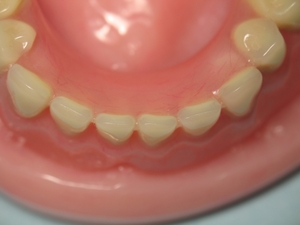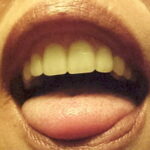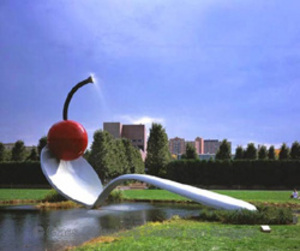As a child, I always admired my big brother. I still do. He retired recently after practicing and teaching dentistry for over 60 years. I think I owe my attention to oral health to my long term respect for him. I remember a remark he made when I asked him about our parent’s full sets of dentures. He said that, properly cared for, our teeth should last a lifetime. He said that when he came back from his stint as a dentist with the Seabees in World War II. Having already been prone to caries, and contemplating the two glasses filled with our parent’s teeth, I had some trouble believing him. Sixty years later, I have all of my own, homegrown, teeth. So does he.
Since as far back as I can remember, I have slavishly followed his (and, later, his son’s) advice about oral care. (I have to mention his most memorable line. In response to one of my children’s question, he said, “No, you don’t have to floss all of your teeth; only the ones you want to keep.”) Although I did not follow him into his profession, I would warrant that my dental health exceeds my health condition more intimately related to my own profession. (Figure it out) In all of those intervening years, I have attended to, used, and evaluated toothbrushes. In the last few years, the cheap, oscillating, battery powered toothbrushes have swept the market and, undoubtedly, improved oral care in this country. That is not because the good, old fashioned, hand toothbrush cannot be used to as good effect; it can, but it rarely is. The ease of use and stimulating feeling provided by these inexpensive, ‘electric’ toothbrushes has clearly increased tooth care in this country (and probably many others).
About a year and a half ago, my brother visited me, driving the 700+ mile distance with ease. That rather scares me; at nearly 20 years his junior, I no longer like to drive to the grocery store, but I already said I admire him. He was carrying with him several sets of Crest battery powered toothbrushes as gifts for my family. For years, I had remembered his admonition that proper brushing technique, with a quiet, immobile, hand toothbrush, provided every bit as good a result as the very expensive electric toothbrushes that had been available for many years. When I reminded him of this, he, somewhat apologetically, said what I quoted above, that it really was easier and more likely to do a good job with the electric kind. I thanked him graciously and placed the new bounty of toothbrushes into my already copious collection of similar appliances. I had arrived at that conclusion independently. So why all this preamble? It is my way of describing the degree to which I have bought, tested, and used virtually every type and brand of toothbrush ever sold. And this, the rather pretentiously named, Oral-B ProfessionalCare 8850 DLX (does that mean deluxe?) oral care system is the best of them. However, that’s not quite the end of the story.
Oral-B is a very good name in toothcare. Their ads are correct, it is the favorite brand of dentists. There are several reasons for that, including promotion, but the truth is that the main reason is that they make very good toothcare products. BrAun, with or without the outsized ‘A’ in their name, is a good name in small appliances. The expectation, then, is of a well made, well designed product, and that is what this is. It is, also, a very expensive product, both to buy and to use. OK, the data that make it a good toothbrush.
The 8850 is a large appliance as toothbrushes go. With its head, it’s about nine inches long, making it slightly longer than the standard toothbrush, including the cheap battery jobs. It’s also a bit heavier than any of the others I have used, but only slightly so and not aversively heavy or awkward. In fact, the overall feeling is one of sturdiness. The power is supplied by a mercury, cadmium, and lead free nickel-metal hydride battery that is deliberately difficult to access. Aside from the relatively friendly environmental aspects, this battery has several advantages over other types of batteries, rechargeable or not. First of all, it is rechargeable, many times, in fact in the several thousand range before it dies permanently. I suspect that the switch or some other mechanism will go first. Secondly, it has a high (but not stated) capacity for a charge. I am guessing that this is in the range of 2300 mAh which will allow it to last about two weeks in steady usage. The last advantage of this type of battery is somewhat more subtle but very important. This battery does not have nearly as much of the ‘memory’ problem of the older Ni-Cad type. That is, they are not limited to the capacity that is habitually used. If you do not regularly allow Ni-Cads to discharge fully, they will lose their capacity to do so. The nickel metal hydride battery is much less sensitive to that phenomenon, but not entirely free of it. It is, therefore, a good idea to let the battery fully discharge every few weeks and then recharge completely before using. It takes about 16 hours to recharge in its own stand, which contains the charger. This docking station can be either free standing or wall mounted.
The appliance itself has a flat bottom that allows it to stand on its own, but it also fits into its stand, which contains other heads and a continuous charger (which cannot overcharge the battery). The movement of the brushhead is both an oscillation in a small arc that is advertised to have a maximum 8,800 oscillations/minute. That is considerably faster than the battery units, and, in fact, faster than any of the expensive “sonic” units I have seen. In addition, with any of its (three different) brushing heads, it ‘pulsates’ at 40,000 beats/min. That’s fast, too and serves a useful purpose in loosening plaque. These speeds can be adjusted downward for the taste of the user, but its brushing advantage lies in its maximum settings.
The 8850 comes with five different heads, two of which are fairly standard tooth brushing devices, a simple, round head and a head containing ‘multi-angle’ brushes that are favored by some consumers. However, the medium soft, small, round head is actually the optimal size and stiffness for usual dental care. There is another head that is round and contains a ‘polishing’ cup intended to remind the brusher of the final polishing experience in tooth cleaning. There are two flaws in this reasoning, however. One is that most people don’t (and shouldn’t) use a polishing compound that is more abrasive than standard toothpaste. The other, and more serious lack is that a dental cleaning involves as deep scraping process that is in no way duplicated by this (or any) brush. The other two heads are rather gimmicky appliances designed to “freshen the tongue” and pick between the teeth. Personally, I rather like interdental picks, but this one is a bit aggressive for my taste. It tickles my lips. I have not found any unique use for the “tongue freshener.” This is an update that I felt compelled to write. I have been playing with the “tongue stimulator” and now, I rather like it, although it still accomplishes nothing more than the other heads that can be run over the tongue. I like the way it does it.
OK, there are other ‘bells and whistles,’ some of which are useful. There is an internal timer that burps the motor every 30 seconds and outright belches at the two minute mark This is intended to remind the brusher to give equal care to each quadrant of the mouth and provide a full two minute brushing, as has been recommended by dentists since the dawn of time. For whatever reason, this works incredibly well for me. A previous (five dollar) battery toothbrush had a two minute switch (it simply turned itself off) that I found somewhat useful, too; but this thirty second warning and the two minute sputter works much better. Besides the cheap job kept turning itself on and off at irregular intervals, and, after trying three of them, I gave up. Their inner workings were not well shielded from water, which had an interesting effect on the switching mechanism. The 8850 is much better constructed and I have encountered no such problem. On the other hand, it costs 24 times as much.
On some of the heads you can use, the bristles of the brush head will signal when they need replacement by a color change. However, if visual inspection of the state of the bristles fails to give the user the same cue as the change in color, tooth brushing help isn’t all this consumer needs. So, in all, The Oral-B 8850 (etc.) is an excellent toothbrush. It has all of the features that any combination of other brushes have, it is well made and, as far as I can tell, does its job(s) as well or better than any competition.
Rush right out and buy one? Not quite so fast. At the retail price of $119.95, you would be paying a great deal for the pleasure and relatively small advantage of this product. The price has come down some in recent months, largely from discount stores and a multibrush package that reduces the cost per unit substantially. However, it is still far more expensive than many good alternatives. Even so, I like it enough to recommend its purchase, with one additional caveat. Keeping and using this toothbrush is also am expensive proposition. New heads are very expensive. They will probably need changing perhaps every six to ten weeks depending on use. The refill brushes come singly and in packages of several heads. The most economical packaging I found was a pack of three heads for about $22.00. You can get four and one fifth very competent entire toohbrushing appliances for that price. In fact, Oral-B makes a five buck battery version that is quite a good toothbrush. Oh, it isn’t as powerful, gimmicky, or flexible as this top of the line gizmo, but it’s a good toothbrush, and that may be all most people want. You can buy twenty-four whole little brushes, complete with batteries (although not rechargeable) for the price of one of these appliances. What this means to me, is that it is an entirely individual decision whether or not it is worth the high price to use what probably is the best toothbrush available. It is certainly possible to take good care of your teeth without it. As I said, it is an individual decision. I wouldn’t give mine back, or trade it for any number of the cheaper variety.
An additional observation worth mentioning is the suggestion/warning they supply with the instructions. They recommend that you smear the toothpaste on your teeth before you begin brushing, not leaving any sizable bolus on the brush head itself, in order to minimize splashing of toothpaste on your cloths. Believe them. In fact, even with this precaution, being something of a slob, myself, I find I need to brush before dressing in the morning, and after undressing at night. In between? I’m very careful





